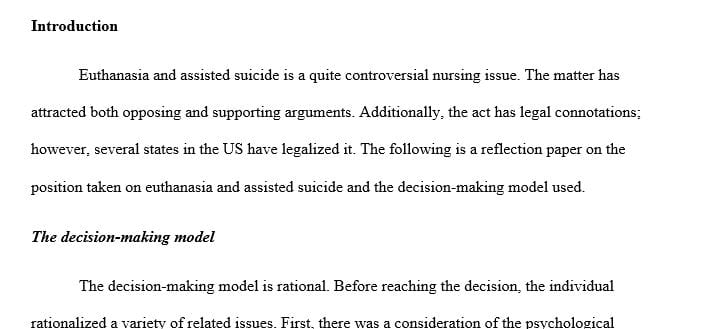Reflection: Current Issues in Nursing
Reflection: Current Issues in Nursing
This individual assignment helps you reflect on your Learning Team activity. Use the same topic and position to complete this assignment.
Summarize the decision-making model you employed and the process used to arrive at your position.
Review the following resources from the Week 3 Electronic Reserve Readings if you need additional information about ethical decision-making models:
“An Integrated Ethical Decision-Making Model for Nurses”
Nursing Ethics in Everyday Practice: A Step-By-Step Guide, Ch. 2: Ethical Decision-Making
Summarize and explain each person’s position and evidence.
Explain how seeing the positions and evidence of others changed or reinforced your position.
Format your assignment as one of the following:
18- to 20-slide presentation
15- to 20-minute oral presentation
875-word paper
Another format approved by your instructor
Cite at least 3 peer-reviewed sources published within the last 5 years that support your positions.
Include an APA-formatted reference list.
Select the Assignment Files tab to submit your assignment.
sources for this assigment:
Euthanasia and assisted suicide
Euthanasia and assisted suicide is essential and should be legalized to patients in their end-of-life stages going through too much pain and suffering.
Euthanasia and assisted suicide are applicable to cases of patients who are experiencing excruciating pain and are also suffering too much psychological in their end of life treatments. It is worth noting that physicians only qualify a patient as a terminal ill if they realize that there is no cure to their condition, and that they might not survive for more than 6 months. It is clear, therefore, that the patient will die soon from the condition (Radbruch et al., 2016). For many years, public opinion on physician assisted suicide has fallen in favor of rejection of the idea than accepting it in the United States. However, recently, there has been a great shift of public opinion on the issue, with a majority of Americans now suggesting that they would invite the idea. Since 2012, physician assisted suicide has been made legal in 7 states and the District of Columbia.
Three US Supreme Court cases, Gonzales v Oregon, Vacco v Quill, and Washington v Glucksbergwere all ruled out of favor of the patients who sought physician assisted suicide, with the court holding that the fourteenth amendment does not protect the right to die. However, scholars have since seen contradiction in these Supreme Court ruling, seeing them as a way of violating the right to privacy, due process, and equal protection. Hansel believes that the supreme court in these instances failed to answer the question “what is life?” and “When does it end?” (Richards, 2017).
Hansel proposes that whole brain death be used in in describing death, and to assist the courts to decide on cases of euthanasia. Whole brain death is a case where a patient sustains irreversible cessation of circulation and respiration, or an irreversible cessation of the whole brain, including the brain stem (Thurston, 2019). In such a condition, the remaining part of life for the patient is mainly suffering without feeling, or even suffering with unending pain, and there is no way the patient will come back to their normal functioning. It seems that the patient may only be suffering, and terminating their life at this state is a way of ending suffering.
I agree with the fact that Euthanasia is a proper way of ending suffering to a terminal-ill who is going through excruciating pain that is even hard to relieve. This is because the patient will eventually die, and if they wish to die earlier than expected, it can relieve them some suffering. It is also clear that the patient should be protected by the equal protection clause of the constitution, and choosing to die is a private decision that should not be dictated by the state.
References
Radbruch, L., Leget, C., Bahr, P., Müller-Busch, C., Ellershaw, J., De Conno, F., … & board members of the EAPC. (2016). Euthanasia and physician-assisted suicide: a white paper from the European Association for Palliative Care. Palliative medicine, 30(2), 104-116.
Richards, S. M. (2017). Death with Dignity: The Right, Choice, and Power of Death by Physician-Assisted Suicide. Charleston L. Rev., 11, 471.
Thurston, A. (2019). Physician-Assisted Death: A Selected Annotated Bibliography. Law Libr. J., 111, 31.
Solution preview for the order on Reflection: Current Issues in Nursing
APA
912 words
